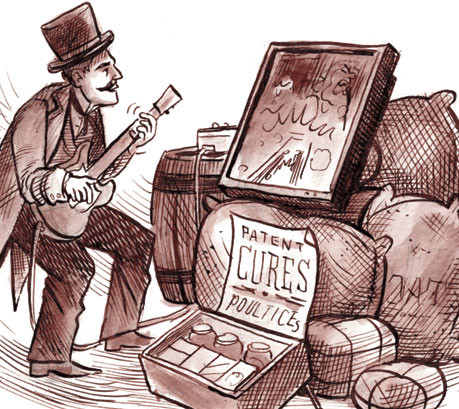It’s odd to think of the Wild West as something that could be “closed,” like a cardboard box or a failed department store. And yet the 1890 US Census did precisely this, with the audacious announcement that the government would no longer tabulate western migration, as the frontier region had ceased to exist. With one stroke of a pen, the entire Wild West—all its buttes and prairies and outlaw towns and poorly lit whorehouses—became simply the West, just one more region of the United States. Throughout the 1890s, academics debated the psychic impact of this closing on a country that no longer had anywhere to go.
Thirteen years later, a 12-minute motion picture called The Great Train Robbery ushered in the genre of western films. It’s a grubby little movie, crude and surprisingly violent. It was also the first film to use crosscuts, double exposures, and location shooting. For many Americans, The Great Train Robbery was the first movie, period. When the leader of the outlaws stared into the camera and fired his gun straight at the viewer, early audiences reacted with panic.
If the arbitrary absurdity of the census ruling didn’t kill the Wild West, The Great Train Robbery certainly did. Dime novels, minstrel shows, and traveling exhibitions had been repackaging cowboy legends since before the Civil War, but it took the new medium of film to coalesce folklore into genuine mass culture. Within a decade, the “western” was a staple of silent film, and actors like Tom Mix were working out the mechanics of how to be a movie star.
To a startling degree, modern America finds itself in the same position almost exactly 100 years later. Rock ’n’ roll is to 21st-century America what the Wild West was to 20th-century America: a closed frontier, ripe for mass mythology. Because our era’s perspective begins with a pop culture that’s already rife with mythologies, we are particularly blind to the colossal impact that rock music—from Bill Haley to grunge—will have on the century before us.
This century even has a direct analogy to The Great Train Robbery. In just five years, Guitar Hero has mushroomed into a multibillion-dollar franchise, complete with clones, sequels, and competitions. Idols of classic rock lend their talents to the game’s software just as Wyatt Earp once consulted for John Wayne and filmmaker John Ford. Guitar Hero’s medium—virtual direct participation—is still in its infancy, much as the film industry was in 1903. In decades to come, immersive, three-dimensional multiplayer rock gaming will open new emotional channels for future music fans, avenues for self-expression unrelated to songwriting or performing as we know it (and this doesn’t include unforeseeable innovations, much as CGI would have been unimaginable to 1903 filmmakers). If you ever felt that shiver of excitement hearing the crowd roar as your virtual representative sauntered onstage, just imagine what that experience will be like with 3-D, high-def eyewear, in full stereo, in a seemingly real concert hall, with no TV screen between you and your adoring audience.
It’s not hard to see the game’s enchanted-mannequin characters as primitive precursors to the photorealistic gaming that’s just a few years away. The game itself offers plenty of sneak peaks into the near future of a music-gaming singularity. In 2008, Metallica fans traded Guitar Hero versions of the band’s new album Death Magnetic in protest against the retail album’s alleged overcompression. Last year’s controversy over Kurt Cobain’s maltreated Guitar Hero avatar—a ghost marionette condemned to endless karaoke—surely heralds the many upcoming conflicts involving CGI and celebrity spirits.
Guitar Hero debuted in 2005. By the logic of the Great Train Robbery analogy, this would backdate rock ’n’ roll’s conclusion to the early 1990s (snarkier writers than I might date 1994—the death of Cobain and the birth of Creed—as the year of death for the genre, if not all of popular music). That’s a bit of a sloppy endpoint, but not entirely so. Certainly, there haven’t been any new mass-marketing labels like “grunge” since grunge.
What can be charted rather precisely is the dearth of new hit makers in this century. Here’s Billboard magazine’s Top Tours of 2000-2009:
Videos by VICE

More
From VICE
-

Screenshot: Chucklefish -

Photo: Visionhaus -

(Photo by Niels van Iperen/Getty Images) -

Photo by Ethan Miller/Getty Images
